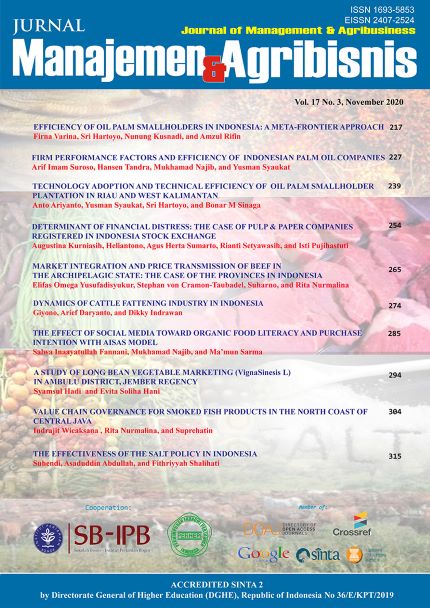TECHNOLOGY ADOPTION AND TECHNICAL EFFICIENCY OF OIL PALM SMALLHOLDER PLANTATION IN RIAU AND WEST KALIMANTAN
Abstract
This study was conducted to assess the role of adoption of oil palm cultivation technology that has been recommended by the government (RI Regulation of the Minister of Agriculture No 131 / Permentan / OT.140 / 12/2013 concerning Guidelines for Good Oil Palm Cultivation) on production efficiency from smallholder plantations on the dependent smallholder and independent smallholder in Riau and West Kalimantan. Specifically, this study is: (1) to analyze the factors that influence the level of production and analyze the technical efficiency of smallholder oil palm in Riau and West Kalimantan, (2) to analyze the effect of intensity of technology adoption on productivity and efficiency of smallholder oil palm production in Riau and West Kalimantan, (3) To identify the factors affecting technical inefficiency in smallholder plantations in Riau and West Kalimantan. The research objectives were analyzed by using a stochastic frontier model to estimate productivity, the level of technical efficiency, and producer inefficiency simultaneously with allocative efficiency and economic efficiency. The results showed that smallholder oil palm farmers who adopt all recommended technologies compared to farmers who adopt not all recommended technologies had higher production efficiency. Analysis of technical efficiency showed that farmers in the dependent smallholder were more technically efficient than independent smallholders. Farmers who adopt more technology and had more experience, had higher efficiency than others. Farmers who were often associated with extension workers and more experience had higher efficiency than others.
Keywords: oil palm smallholder, technology adoption, technical efficiency, Riau, West Kalimantan
Authors
Authors who publish with this journal agree to the following terms:
- Authors retain copyright and grant the journal right of first publication with the work simultaneously licensed under a Creative Commons Attribution License that allows others to share the work with an acknowledgement of the work's authorship and initial publication in this journal.
- Authors are able to enter into separate, additional contractual arrangements for the non-exclusive distribution of the journal's published version of the work (e.g., post it to an institutional repository or publish it in a book), with an acknowledgement of its initial publication in this journal.
- Authors are permitted and encouraged to post their work online (e.g., in institutional repositories or on their website) prior to and during the submission process, as it can lead to productive exchanges, as well as earlier and greater citation of published work (See The Effect of Open Access).

